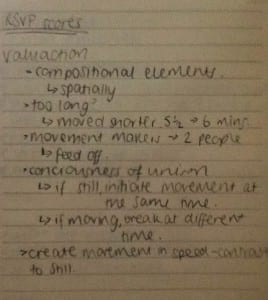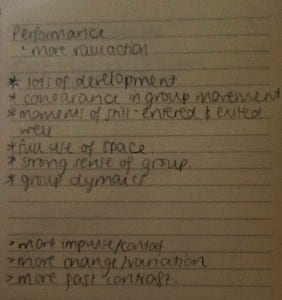Experimenting with improvisation over the series of weeks has been the most rewarding challenge, opening my eyes to so many different methods of improvisation and developing my movement vocabulary and creative ability. My development has been hugely reinforced by learning the strategy of reflection. Reflection was something I felt would be particularly hard for me however has really led me to think deeply about my own personal experimentation. Boud stated that “reflection involves taking the unprocessed, raw material of experience and engaging with it as a way to make sense of what has occurred” (Boud, in Little, 2010, 41) which I felt influenced the way I looked at reflection. This taught me that reflection involves closely looking back at what has happened and trying to decide what the experimentation meant to me and what it showed. It has provided me with the means to pose questions on myself as well as improvisation to enable me to expand my learning and find out about myself.
I discovered that the most effective strategy to generate new unhabitual movement for me was the use of imagery. Retouching upon imagery this week taught me it could also be used to develop movement so that it isn’t habitual rather than just used to generate movement. This would help me in creating coherence throughout my movement while making every improvised motif different and original. I then used this further in our own scores, creating movement based on the different imagery so that the movement I performed throughout the piece was varied but had an intention.
Reducing habitual movement has been one of the greatest challenges for me as my original feelings to improvisation were centred on what was right and what was wrong. I feel that my practice has developed to a point where my habitual patterns are much less evident in my performance however can come back when I feel stuck. However, I have learnt that I have tendency’s to favour strategies, particularly thick skinning, making them become habitual for me. My habitual preferences have therefore shifted so the movement I perform generally has changed however new ones have developed. This is something I would like to continue to develop so that every performance I produce is new and innovative.
Adding music to the improvisations had a really interesting effect as I discovered it changed the way the performers danced, personally leading me to return to habitual movement. I learnt this was because there is a natural instinct to go with the music and by focusing on fitting movement to the music I resulted back to my old habits in movement. This is another thing I would like to develop further. I would like to discover strategies in which I can ignore the music, holding my focus on movement generation so that I can create contrasts between the movement and the music.
I also learnt that there are so many different ways to form a relationship with other performers, such as impulse and interpretation, that all create completely different effects. Learning the new strategy of tracking a partners head, pelvis or both was really interesting as it was a method I would never have thought of myself. I found it was often quite difficult to keep contact when the other performer would move a lot and also I found it really hard to track them when the distance was increased and the hand was dropped. I attempted to use this strategy within the pop up scores and the open score of the jam however I found it difficult to make it clear this was my intention when I wasn’t physically touching or next to my partner. I discovered the most effective way of using this strategy for me was by moving into my partners hand, allowing them to support my body at times and then moving away to create contrast. I then developed this when I used my hand as I tried to provide support for the other dancer, particularly when tracking their head, while in some ways using the strategy to manipulate them.
For this, however, I discovered a high amount of awareness to others is needed, which is an aspect I would like to develop further. This was needed so you could sense where your partner would move or go in order to keep a close track which was very difficult. I feel developing even further skills of awareness will enable me to form relationships stronger as I would be able to see and sense what the performers would do and create a connection. I also want to discover ways to be openly aware to the composition of the space while performing as I have found over the weeks it is still difficult to design the space effectively when you are performing. I have developed these skills when viewing and entering the piece however I would like to be able to transfer this to when I am always performing.
The main thing I have learnt over the course of experimentation is the importance of the audience. Within improvisation, contrasting to many other dance forms, the roles of the audience and performer are often of equal importance. Ruth Zaporah states “the audience, and me, and the forces that are floating through the room are all interacting with one another to create the content of the evening” (Zaporah in De Spain, 2014, 65) which supports my discovery about the audience. This idea shows that the audience has an active input in the work and can affect what happens within the piece. I discovered that effective improvisation often uses the audience, whether it is to affect the movement the dancers are performer or the space they are in. this was seen in one of the group scores where audience members were required to call out and the performers would have to respond appropriately. Experimenting with the pop up scores at the end showed me the different positions of which the audience could be in, whether they view from the front or create a corridor or are moving through the work. Each of these placements affects the intentions of the work and the space in which the performers use as they need to engage the audience from whichever position.
The final big discovery I have made has been about time. This is that the difference between felt time and actual time is incredible and particularly in improvisation. “Body time is measured from the internal sensing of time as opposed to the time on a clock; it can be much slower or pass more quickly than clock time” (Buckwalter, 2010, 60) which became evident in improvisation as there would be no way of measuring the exact time when performing. Often dance works are choreographed down to the second so that they fit in a set time and that the work is a set length beginning to end, each section or appropriate lengths. However I have learnt that in improvisation it is nearly impossible to judge time and I would get lost within the score, finding it finish much earlier than I expected and before I felt I was ready or done exploring. This really surprised me in week 4 where we attempted to calculate time without clocks. Buckwalter suggests “dancemakers use cues from the body or improvised material as the timekeeper” (Buckwalter, 2010, 60) which is something I have found particularly hard. Sensing the appropriate length of the piece and using this to find development and natural endings is a challenge as sometimes the cues from the body wouldn’t be evident even too me. I would like to learn more about, performing scores of varying lengths in order to find developments and experimentation’s earlier in the score in order for each score to have a clear intention even when it is only a minute long.
In my further studies I will use the strategies and modes of improvisation in generating new and innovative movements with a clear intention. I will particularly use imagery to emphasise the intentions while also using improvisation when I feel stuck in choreography. I will improvise without music and add music later to avoid habitual patterns to arise. Using methods of tracking back will allow me to remember what I performed while also filming to find particular parts that I liked; I discovered that it was easier to remember the parts of the sequences that I liked. Reflection would then be used in the form of ‘pow wows’ to look back and develop my pieces further, making them more compositionally interesting. I feel what I have discovered are keys to producing new choreography that will engage and audience and make them ask questions on my works.
Buckwalter, M. (2010) Composing while dancing: An Improviser’s Companion. Madison, WI, USA: The University of Wisconsin Press.
De Spain, K. (2014) Landscape of the Now. New York, NY, USA: Oxford University Press.
Little, M. (2010) Creating the Reflective Student-Practitioner. Australasian Drama Studies, 57 38-53.


